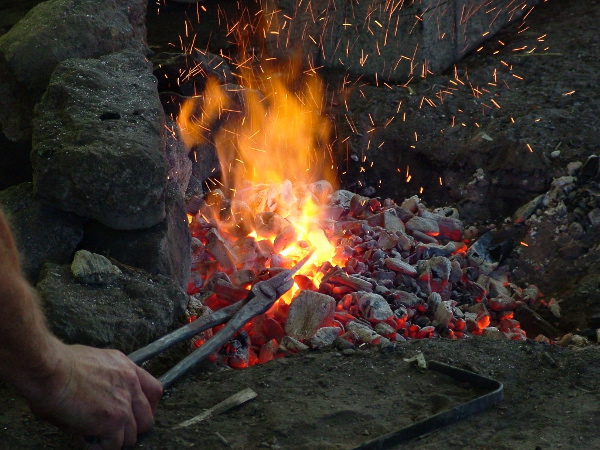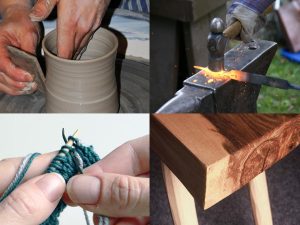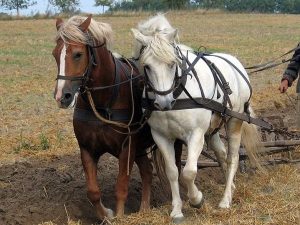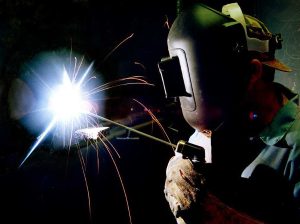Blacksmithing & farriery - introduction

“Strike while the iron is hot.” – proverb
Contents
What is blacksmithing and what is farriery?
Blacksmithing is the forging (hammering), bending, cutting and joining of metal by using heat to soften it. At the heart of a blacksmith’s workshop is the forge – a hearth for providing heat – although the word forge is often used for the entire workshop. Farriery involves many of the same skills, but with a focus on making and fitting horseshoes. When there were blacksmithing apprenticeships in Britain, after three years basic training, apprentices branched into either large-scale industrial blacksmithing, small-scale ‘village’ blacksmithing or farriery, which included some veterinary training.
Most modern blacksmiths work with steel, but traditionally they would have worked with wrought iron. Wrought means ‘worked’ (by hand). Wrought iron is malleable and can be forged because it has a low carbon content, like steel. Cast iron is brittle and will break if worked – it has a higher carbon content and can only be cast in moulds. Most items described as wrought iron today are in fact mild steel. Mild steel is the most commonly-used steel, but blacksmiths can sometimes work with specialist steels like stainless, or other metals like brass, copper or bronze.

History
Metalworking goes back to the Bronze Age (roughly 3000-1300 BCE); bronze is an alloy of copper and tin and has a relatively low melting point, making it easy to work. The people who learned to smelt iron conquered the bronze smelters because of the simple fact that their weapons were harder.
Archaeologists were confused by iron implements found in various parts of the world from thousands of years before the Iron age, until they realised that the iron alloys were from meteorites!
Seven basic skills of blacksmithing
After the Romans left Britain, blacksmiths were a disorganised group of mainly Celtic craftsmen who would set up anywhere there was a local population, to make weaponry and tools for farmers and other craftsmen such as woodworkers or leatherworkers. Hence blacksmithing was known as the ‘king of trades’ – as other trades couldn’t operate without them. In 1299 blacksmiths formed a loose association to protect their reputation from unskilled itinerant workers. In 1571, Queen Elizabeth conferred a royal charter to the ‘Worshipful Company of Blacksmiths’, as the governing body for blacksmiths in London. They were so successful that in the early days of the company blacksmiths became magistrates, commissioners for oaths and in Scotland, conducted marriage ceremonies.

In 1860, blacksmith Henry Bessemer invented a process that enabled large quantities of steel to be made cheaply – one of the main stimuli for the Industrial Revolution. In the 19th century, every town and village had a blacksmith – there were over 10,000 working blacksmiths in Britain. Since the de-industrialisation of Britain from the 1970s on, blacksmithing in the UK has re-invented itself, providing design, advice and manufacture and repair of domestic items such as furniture, gates and railings, restoration projects and sculpture. Blacksmithing is currently experiencing a huge revival, and it’s changed a lot. Many more women are entering the profession, and the trade is becoming more artistic in its scope.
Most forges use coal or gas, which are both fossil fuels and will eventually run out. Charcoal (hardwood not briquettes) can be used, but it will require greater quantities, and so will be more expensive. Charcoal is renewable though, but as with most things, it can’t be renewed fast enough to keep up with a constantly-growing economy. Induction heating could be used in future, as well as things we don’t know about yet – because they haven’t been invented.
What are the benefits of blacksmithing and farriery?
- it’s a very useful craft skill that can be turned into a career, providing metal products and services to the community (blacksmiths sometimes even straighten or sharpen garden tools for local people)
- steel is reworkable; if you cut a piece of wood too short, you need another piece – but if you cut a piece of metal too short, you can reheat and lengthen it
- you can help to recycle metals even more by frequenting scrap yards for the raw materials for your creations
- it’s the only trade where you can get the satisfaction of making all your own tools from scratch

What can I do?
You can support your local blacksmith if you have one, rather than a giant DIY store that imports metal goods from the other side of the world. The rest of this section is about setting up your own forge. You might want to do this if you’re a smallholder or farmer who wants to make and repair tools and equipment, or you might be thinking of setting up a small business.
The first thing to do is get some training. Try a taster day first to see if it’s for you. It requires good hand-eye co-ordination, and not everybody has it! It also requires you to be tough, strong and able to work in a hot forge for long periods. On a course you’ll learn: more about tools, equipment and different types of steel; the colour of steel at different temperatures, and what jobs can be done at what temperature – for example hardening, annealing (toughening), bending, forging and welding; plus various techniques such as drawing (lengthening), bending, cutting, upsetting (thickening), punching (making holes), fire-welding and hot-filing.

Then you’ll need a forge/workshop. You can find equipment and raw materials through the website and magazine of the British Artist Blacksmiths Association (BABA). The most important things you’ll need are a hearth/forge, anvil and hammer. A traditional anvil has a flat, hard ‘face’ on which most of the work is done; holes at the back for bending and punching; a ‘horn’ at the front for bending; and a ‘table’ between the horn and the face. The table is for cutting, so it’s not hardened, as that would damage the cutting chisels. After that you’ll need other tools, such as tongs, chisels and cutters. You can buy them, but what better than plying your trade with tools you’ve made yourself? £4000 is a rough estimate of the outlay required to get you set up.
Here are some examples of things you could make or repair: your own tools, axe heads, garden tools, woodworking tools, stone masonry tools, knives and blades, machinery parts, vehicle body parts, candle-holders and other decorative household goods, railings, wood stoves, fire irons, curtain rails, beds, chairs, door-knockers, cooking utensils, jewellery, hinges and latches, chains and of course, horseshoes. There is a lot more information on how to make tools, and also how to build and set up your own forge in books and on our links page (see resources).

If you decide that you’d like to be a blacksmith, you could contact established blacksmiths via the WCB or BABA to see if they will take you on as a trainee and give you on-the-job training. As we write there is no official regulation of blacksmithing, but it’s a good idea to register with the Worshipful Company of Blacksmiths, as they operate like an employment exchange. They pass leads on to their members from individuals (and organisations like English Heritage) who contact them. You can obtain relevant NVQs and diplomas, but really, people will want to see examples of your work. It’s a different story with farriery (in the UK at least) – you have to be a registered farrier to shoe a horse. Legislation was brought in to avoid suffering of horses shod by unqualified people. See the Farriers Registration Council. You can find lots more information on forging a career (do you see what I did there?) in blacksmithing or farriery on our links page, under resources.
Specialist(s)
Thanks to Neil Stuart of Design Blacksmith for information.



